Abstract
The effect of the adenylate cyclase activator forskolin on bone resorption and cyclic AMP accumulation was studied in an organ-culture system by using calvarial bones from 6-7-day-old mice. Forskolin caused a rapid and fully reversible increase of cyclic AMP, which was maximal after 20-30 min. The phosphodiesterase inhibitor rolipram (30 mumol/l), enhanced the cyclic AMP response to forskolin (50 mumol/l) from a net cyclic AMP response of 1234 +/- 154 pmol/bone to 2854 +/- 193 pmol/bone (mean +/- S.E.M., n = 4). The cyclic AMP level in bones treated with forskolin (30 mumol/l) was significantly increased after 24 h of culture. Forskolin, at and above 0.3 mumol/l, in the absence and the presence of rolipram (30 mumol/l), caused a dose-dependent cyclic AMP accumulation with an calculated EC50 (concentration producing half-maximal stimulation) value at 8.3 mumol/l. In 24 h cultures forskolin inhibited spontaneous and PTH (parathyroid hormone)-stimulated 45Ca release with calculated IC50 (concentration producing half-maximal inhibition) values at 1.6 and 0.6 mumol/l respectively. Forskolin significantly inhibited the release of 3H from [3H]proline-labelled bones stimulated by PTH (10 nmol/l). The inhibitory effect by forskolin on PTH-stimulated 45Ca release was significant already after 3 h of culture. In 24 h cultures forskolin (3 mumol/l) significantly inhibited 45Ca release also from bones stimulated by prostaglandin E2 (1 mumol/l) and 1 alpha-hydroxycholecalciferol (0.1 mumol/l). The inhibitory effect of forskolin on spontaneous and PTH-stimulated 45Ca release was transient. A dose-dependent stimulation of basal 45Ca release was seen in 120 h cultures, at and above 3 nmol of forskolin/l, with a calculated EC50 value at 16 nmol/l. The stimulatory effect of forskolin (1 mumol/l) could be inhibited by calcitonin (0.1 unit/ml), but was insensitive to indomethacin (1 mumol/l). Forskolin increased the release of 3H from [3H]proline-labelled bones cultured for 120 h and decreased the amount of hydroxyproline in bones after culture. Forskolin inhibited PTH-stimulated release of Ca2+, Pi, beta-glucuronidase and beta-N-acetylglucosaminidase in 24 h cultures. In 120 h cultures forskolin stimulated the basal release of minerals and lysosomal enzymes.(ABSTRACT TRUNCATED AT 400 WORDS)
Full text
PDF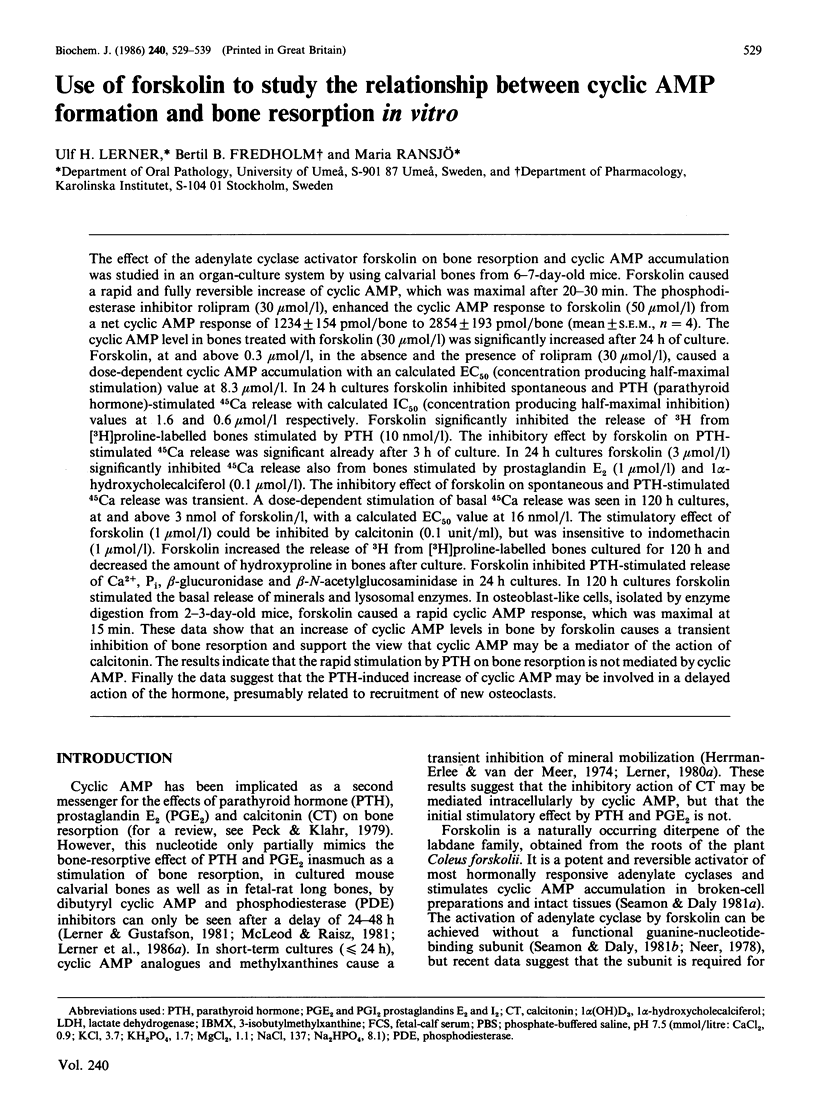
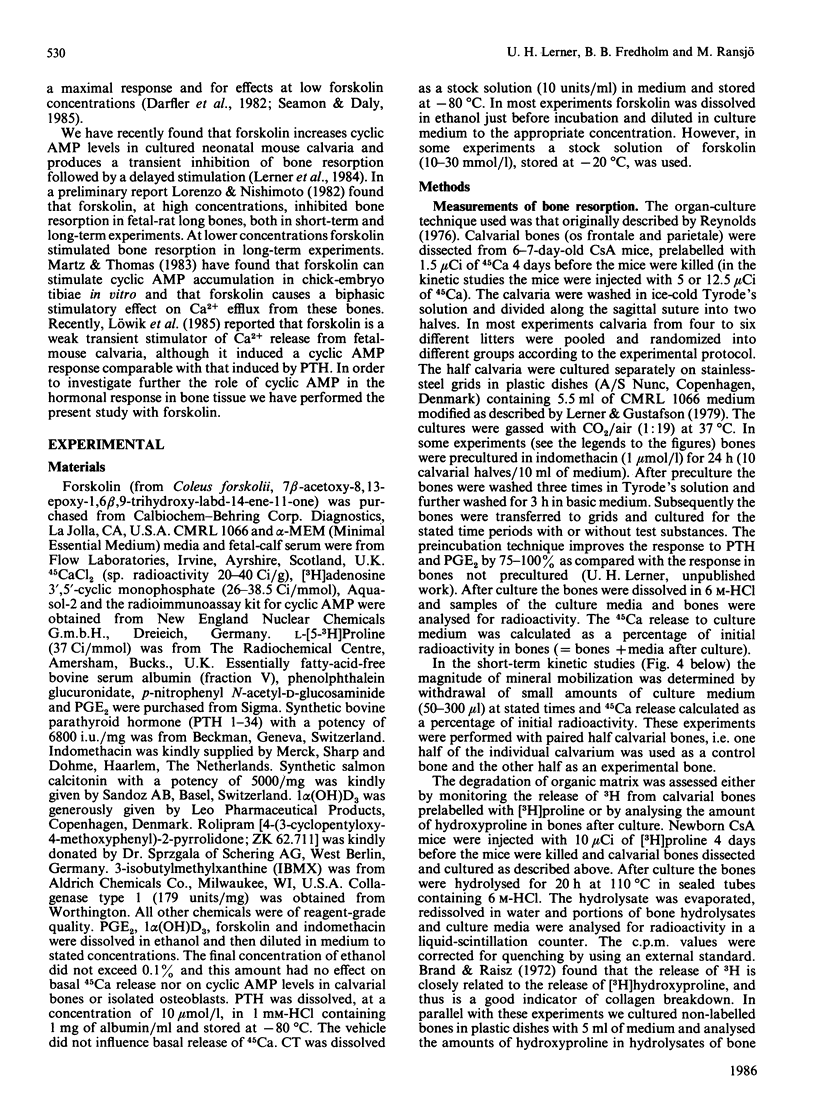
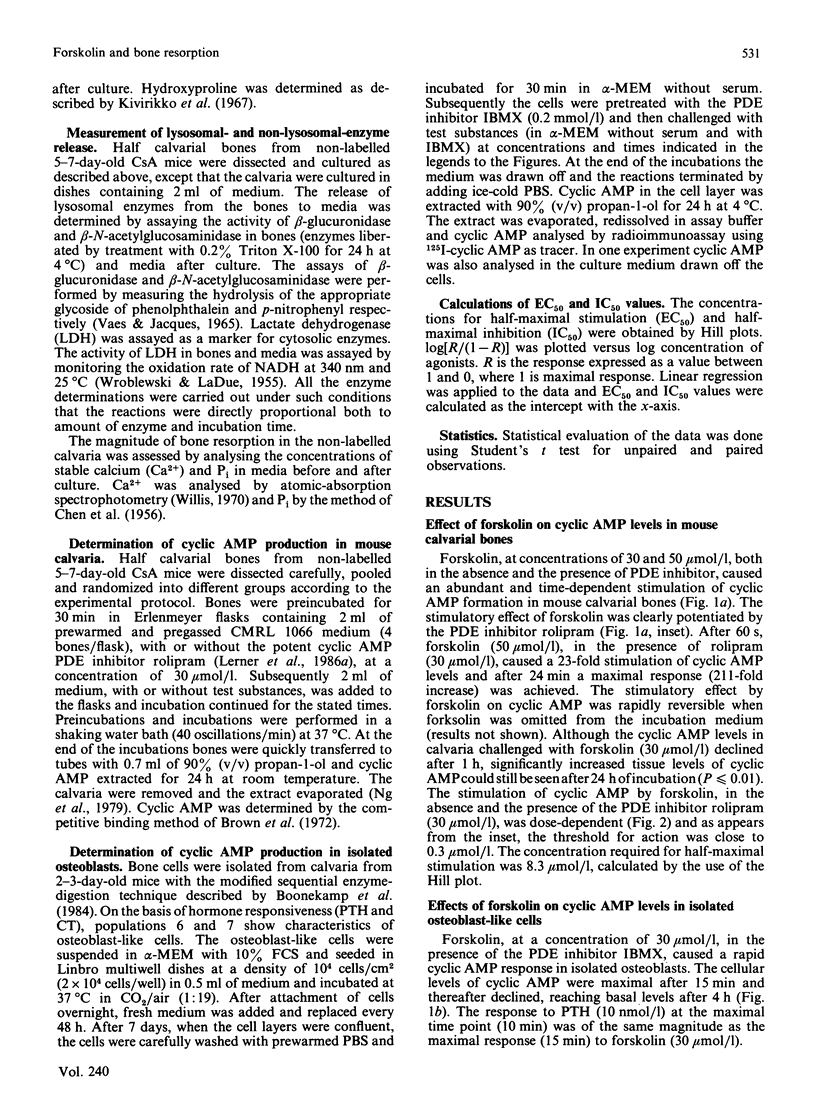


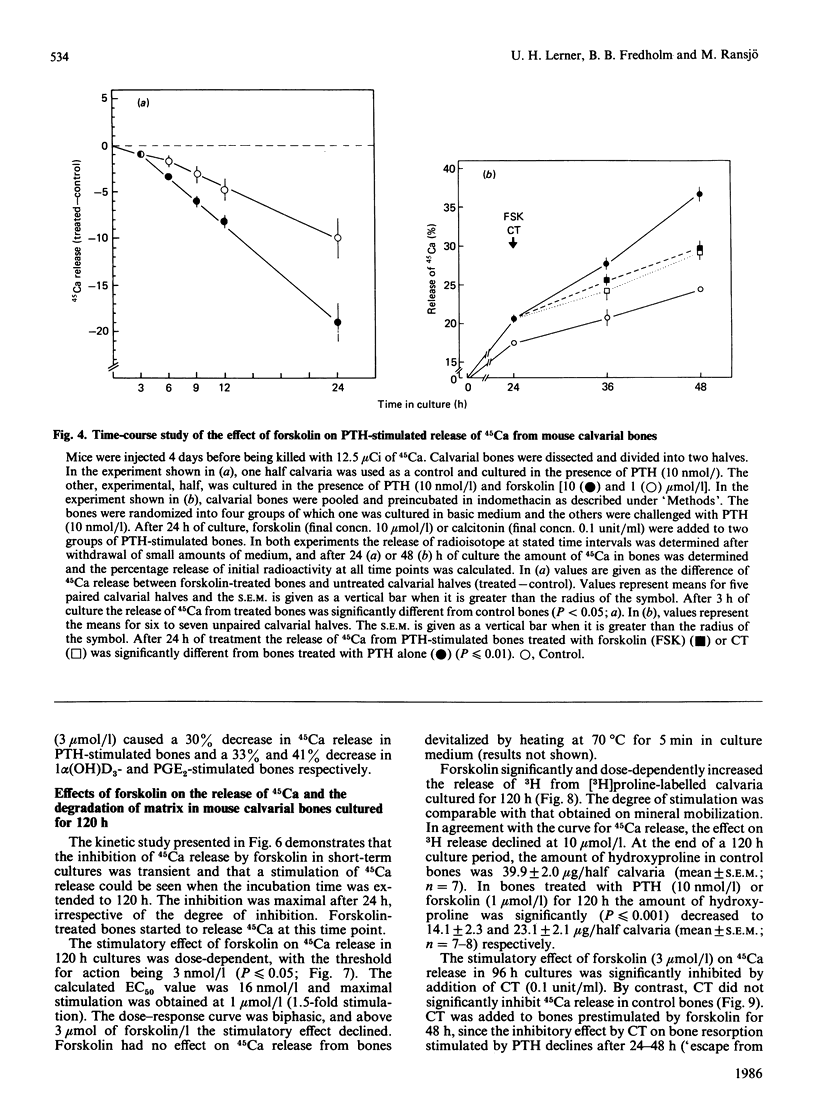
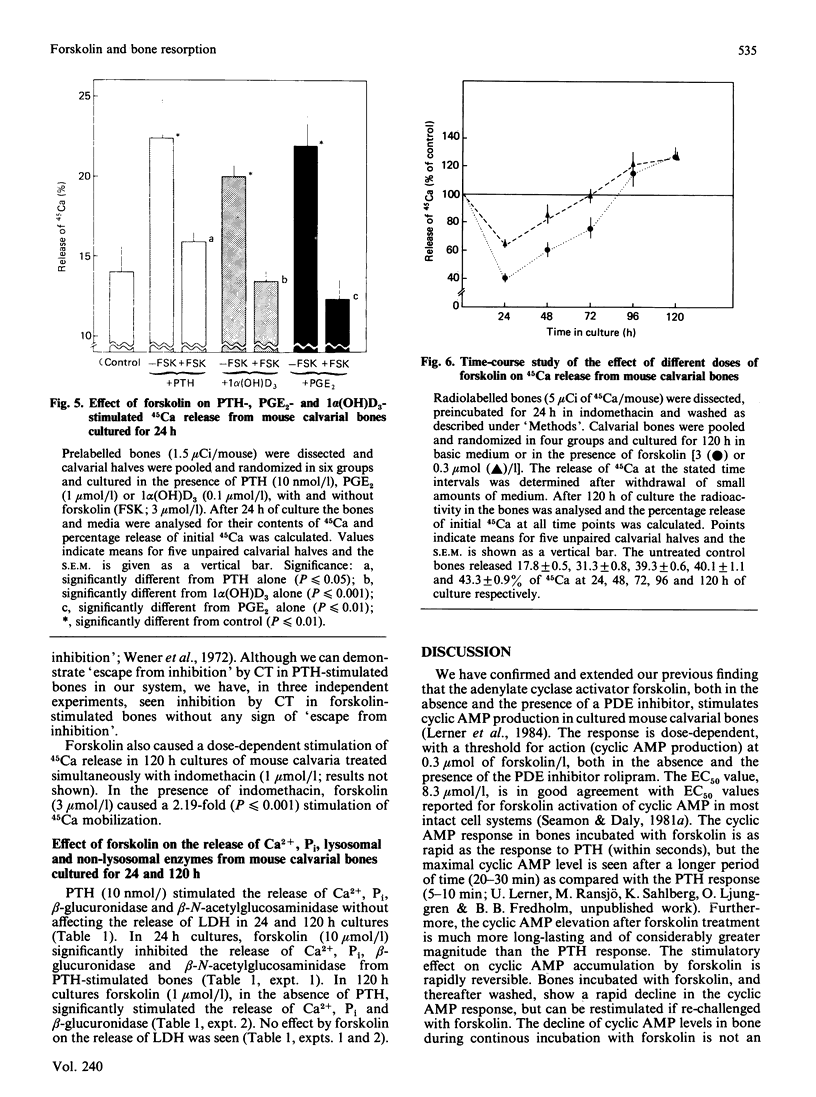

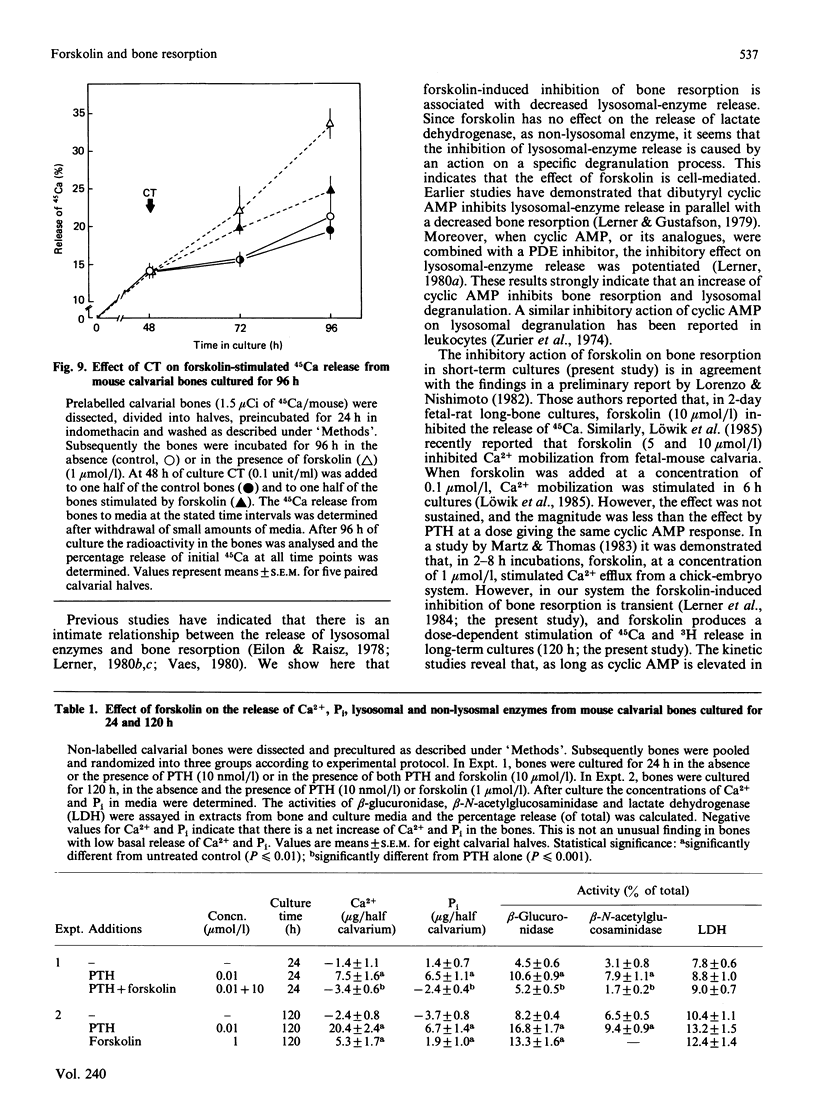

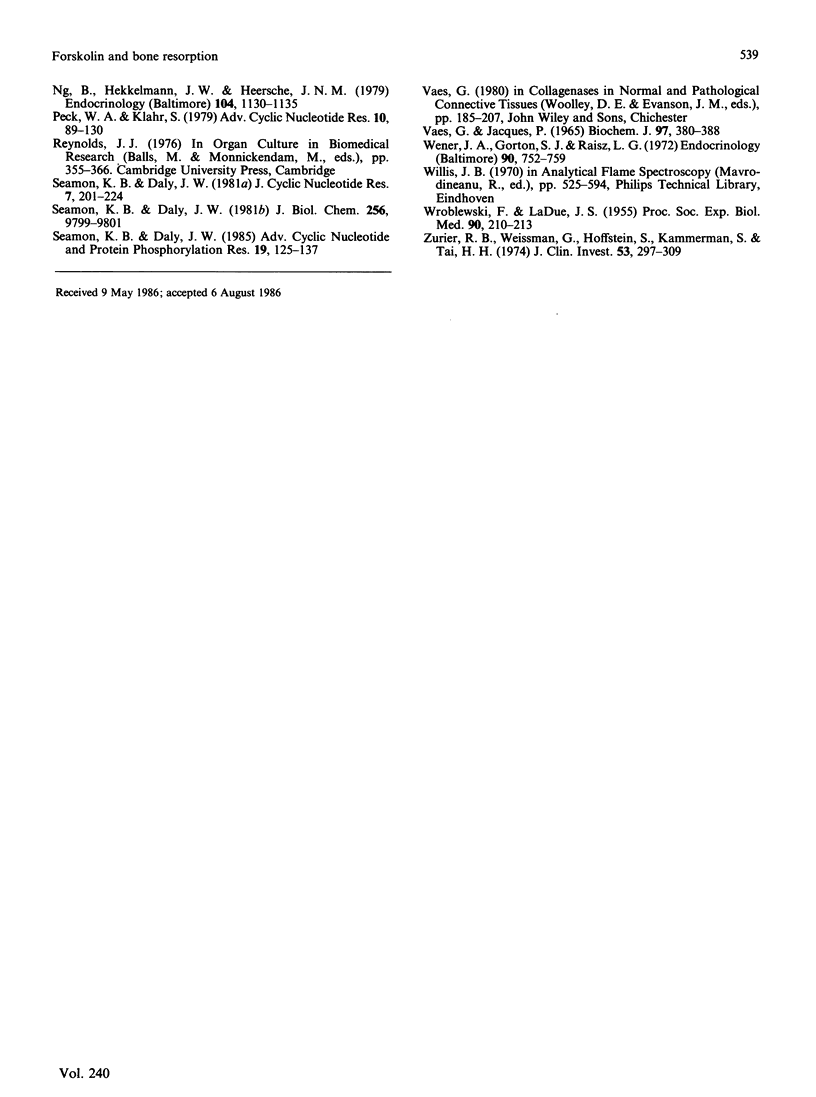
Selected References
These references are in PubMed. This may not be the complete list of references from this article.
- Brand J. S., Raisz L. G. Effects of thyrocalcitonin and phosphate ion on the parathyroid hormone stimulated resorption of bone. Endocrinology. 1972 Feb;90(2):479–487. doi: 10.1210/endo-90-2-479. [DOI] [PubMed] [Google Scholar]
- Brown B. L., Ekins R. P., Albano J. D. Saturation assay for cyclic AMP using endogenous binding protein. Adv Cyclic Nucleotide Res. 1972;2:25–40. [PubMed] [Google Scholar]
- Chambers T. J., Ali N. N. Inhibition of osteoclastic motility by prostaglandins I2, E1, E2 and 6-oxo-E1. J Pathol. 1983 Mar;139(3):383–397. doi: 10.1002/path.1711390313. [DOI] [PubMed] [Google Scholar]
- Chambers T. J., Dunn C. J. Pharmacological control of osteoclastic motility. Calcif Tissue Int. 1983 Jul;35(4-5):566–570. doi: 10.1007/BF02405095. [DOI] [PubMed] [Google Scholar]
- Chambers T. J., McSheehy P. M., Thomson B. M., Fuller K. The effect of calcium-regulating hormones and prostaglandins on bone resorption by osteoclasts disaggregated from neonatal rabbit bones. Endocrinology. 1985 Jan;116(1):234–239. doi: 10.1210/endo-116-1-234. [DOI] [PubMed] [Google Scholar]
- Darfler F. J., Mahan L. C., Koachman A. M., Insel P. A. Stimulation of forskolin of intact S49 lymphoma cells involves the nucleotide regulatory protein of adenylate cyclase. J Biol Chem. 1982 Oct 25;257(20):11901–11907. [PubMed] [Google Scholar]
- Eilon G., Raisz L. G. Comparison of the effects of stimulators and inhibitors of resorption on the release of lysosomal enzymes and radioactive calcium from fetal bone in organ culture. Endocrinology. 1978 Dec;103(6):1969–1975. doi: 10.1210/endo-103-6-1969. [DOI] [PubMed] [Google Scholar]
- Herrmann-Erlee M. P., Meer JM vd The effects of dibutyryl cyclic AMP, aminophylline and propranolol on PTE-induced bone resorption in vitro. Endocrinology. 1974 Feb;94(2):424–434. doi: 10.1210/endo-94-2-424. [DOI] [PubMed] [Google Scholar]
- Kivirikko K. I., Laitinen O., Prockop D. J. Modifications of a specific assay for hydroxyproline in urine. Anal Biochem. 1967 May;19(2):249–255. doi: 10.1016/0003-2697(67)90160-1. [DOI] [PubMed] [Google Scholar]
- Lerner U., Fredholm B. B., Hänström L. Diphenylhydantoin inhibits parathyroid hormone and prostaglandin E2-stimulated bone resorption in mouse calvaria without affecting cyclic AMP formation. J Oral Pathol. 1985 Sep;14(8):644–653. doi: 10.1111/j.1600-0714.1985.tb00542.x. [DOI] [PubMed] [Google Scholar]
- Lerner U., Fredholm B. B., Ransjö M. Transient inhibition on calcium mobilization from cultured mouse calvarial bones by the adenylate cyclase stimulator forskolin. Acta Physiol Scand. 1984 Jan;120(1):159–160. doi: 10.1111/j.1748-1716.1984.tb07389.x. [DOI] [PubMed] [Google Scholar]
- Lerner U., Gustafson G. T. Delayed stimulatory effect of cyclic AMP on bone resorption in vitro. Acta Endocrinol (Copenh) 1981 Jun;97(2):281–288. doi: 10.1530/acta.0.0970281. [DOI] [PubMed] [Google Scholar]
- Lerner U., Gustafson G. T. Inhibitory effect of dibutyryl cyclic AMP on the release of calcium, inorganic phosphate and lysosomal enzymes from calvarial bones cultured for 24 hours. Acta Endocrinol (Copenh) 1979 Aug;91(4):730–742. doi: 10.1530/acta.0.0910730. [DOI] [PubMed] [Google Scholar]
- Lerner U. Inhibition of bone resorption and lysosomal enzyme release from calvarial bones cultured for 24 hours: synergism between cyclic AMP analogues and phosphodiesterase inhibitors. Acta Endocrinol (Copenh) 1980 May;94(1):138–144. doi: 10.1530/acta.0.0940138. [DOI] [PubMed] [Google Scholar]
- Lerner U. Relationship between bone resorption and lysosomal enzyme release as demonstrated by the effect of 1 alpha-hydroxy-vitamin D-3 in an organ culture system. Biochim Biophys Acta. 1980 Oct 1;632(2):204–213. doi: 10.1016/0304-4165(80)90078-1. [DOI] [PubMed] [Google Scholar]
- Luben R. A., Wong G. L., Cohn D. V. Biochemical characterization with parathormone and calcitonin of isolated bone cells: provisional identification of osteoclasts and osteoblasts. Endocrinology. 1976 Aug;99(2):526–534. doi: 10.1210/endo-99-2-526. [DOI] [PubMed] [Google Scholar]
- Löwik C. W., van Leeuwen J. P., van der Meer J. M., van Zeeland J. K., Scheven B. A., Herrmann-Erlee M. P. A two-receptor model for the action of parathyroid hormone on osteoblasts: a role for intracellular free calcium and cAMP. Cell Calcium. 1985 Aug;6(4):311–326. doi: 10.1016/0143-4160(85)90002-8. [DOI] [PubMed] [Google Scholar]
- Martz A., Thomas M. L. Effects of forskolin on bone. Stimulation of cyclic AMP accumulation and calcium efflux from chick embryo tibiae in organ culture. Biochem Pharmacol. 1983 Nov 15;32(22):3429–3433. doi: 10.1016/0006-2952(83)90372-6. [DOI] [PubMed] [Google Scholar]
- McLeod J. F., Raisz L. G. Comparison of inhibition of bone resorption and escape with calcitonin and dibutyryl 3',5' cyclic adenosine monophosphate. Endocr Res Commun. 1981;8(1):49–59. doi: 10.1080/07435808109065983. [DOI] [PubMed] [Google Scholar]
- Neer E. J. Physical and functional properties of adenylate cyclase from mature rat testis. J Biol Chem. 1978 Aug 25;253(16):5808–5812. [PubMed] [Google Scholar]
- Ng B., Hekkelman J. W., Heersche J. N. The effect of cortisol on the adenosine 3',5'-monophosphate response to parathyroid hormone of bone in vitro. Endocrinology. 1979 Apr;104(4):1130–1135. doi: 10.1210/endo-104-4-1130. [DOI] [PubMed] [Google Scholar]
- Peck W. A., Klahr S. Cyclic nucleotides in bone and mineral metabolism. Adv Cyclic Nucleotide Res. 1979;11:89–130. [PubMed] [Google Scholar]
- Seamon K. B., Daly J. W. Forskolin: a unique diterpene activator of cyclic AMP-generating systems. J Cyclic Nucleotide Res. 1981;7(4):201–224. [PubMed] [Google Scholar]
- Seamon K. B., Daly J. W. High-affinity binding of forskolin to rat brain membranes. Adv Cyclic Nucleotide Protein Phosphorylation Res. 1985;19:125–135. [PubMed] [Google Scholar]
- Seamon K., Daly J. W. Activation of adenylate cyclase by the diterpene forskolin does not require the guanine nucleotide regulatory protein. J Biol Chem. 1981 Oct 10;256(19):9799–9801. [PubMed] [Google Scholar]
- Vaes G., Jacques P. Studies on bone enzymes. The assay of acid hydrolases and other enzymes in bone tissue. Biochem J. 1965 Nov;97(2):380–388. doi: 10.1042/bj0970380. [DOI] [PMC free article] [PubMed] [Google Scholar]
- WROBLEWSKI F., LADUE J. S. Lactic dehydrogenase activity in blood. Proc Soc Exp Biol Med. 1955 Oct;90(1):210–213. doi: 10.3181/00379727-90-21985. [DOI] [PubMed] [Google Scholar]
- Wener J. A., Gorton S. J., Raisz L. G. Escape from inhibition or resorption in cultures of fetal bone treated with calcitoninand parathyroid hromone. Endocrinology. 1972 Mar;90(3):752–759. doi: 10.1210/endo-90-3-752. [DOI] [PubMed] [Google Scholar]
- Zurier R. B., Weissmann G., Hoffstein S., Kammerman S., Tai H. H. Mechanisms of lysosomal enzyme release from human leukocytes. II. Effects of cAMP and cGMP, autonomic agonists, and agents which affect microtubule function. J Clin Invest. 1974 Jan;53(1):297–309. doi: 10.1172/JCI107550. [DOI] [PMC free article] [PubMed] [Google Scholar]


